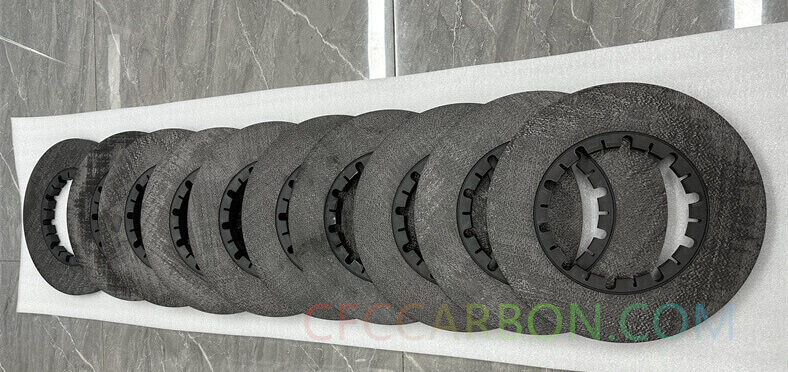The catalytic effect of potassium oxide/carbonate on the oxidation of C-C composites from actual aircraft brakes was investigated by Carabiniero et al. who compared the weight loss between new, used and potassium oxide/carbonate-impregnated C-C samples at a temperature range between 500C and 900C in air.

2.5D needle punch CFC airplane Brake disc-carbon fiber composite preform-preforming-Prefab T700 12K (4)
The potassium oxide/carbonate-impregnated samples exhibited the highest weight loss at all temperatures tested indicating a strong catalytic effect. By employing in-situ electron microscopy, they observed the presence of liquid-like particles on the surface of the carbon fibers at around 650C. In-situ investigation also showed that the XRD peaks of the potassium oxide/peroxide particles tended to attenuate above 700C, indicating the formation of a thin film on the surface of the carbon as observed by in-situ microscopy.
The attenuation of the peaks suggested that peroxides were becoming amorphous. At 700C, the formation of these particles was observed to be followed by rapid oxidation of carbon. According to Carabiniero et al., the oxidation of the fibers was more enhanced than that of the matrix. As for the un-impregnated samples, both new and used C-C composite samples showed negligible weight loss at 500C. However, when subsequently tested at higher temperatures, the new C-C samples showed more prominent weight loss than the used ones. This effect became more enhanced with increasing temperature. The authors explained this finding by arguing that the most active carbon sites had already undergone gasification in the used samples. They also observed within the used C-C samples the presence of phosphorous compounds which are known to inhibit the carbon oxidation by forming an adsorbed layer that acts as a protective barrier.
The mechanistic aspects of alkali metal-catalysed carbon oxidation were explored by Mul et al. who studied the molecular interactions between potassium and partially oxidized carbon black using Fourier Transform Infrared Spectroscopy (FTIR). Infrared absorption banks located around 1100 cm-1 were attributed to the presence of a potassium phenoxide complex; the possible presence of the compound C6(OK)6 was also theorized to justify the presence of similar absorption bands.

airplane brake disc-aircraft carbon fiber composite material manufacturer- (2)
Further bands located between 1300 and 1600 cm-1 were attributed to a bicarbonate species. The authors then conducted in-situ analysis of catalytic carbon black oxidation using Diffuse Reflectance Infrared Fourier Transform Spectroscopy (DRIFTS). They postulated that potassium salts including K2CO3 act as precursors for the formation of potassium oxide compounds. They attributed the absorption bands found at 1120 and 620 cm-1 to chemisorbed CO2. which formed during carbon black oxidation and strongly interacted with potassium oxide clusters. Previous studies had suggested that dispersed potassium oxide was bound to the carbonaceous surface via oxygen linkages and that above 500C the interaction of CO2 with the species formed after decomposition of carbonates resulted in the formation of infrared absorption banks around 1110 cm-1.
Stelko and co-authors assumed that the catalytic gasification of carbon was the result of electron exchanges between a metal and the carbon matrix, leading to the formation of oxides of carbon and metal-carbon complexes. In particular, carbon dioxide which was liberated by the thermal decomposition of K2CO3 effectively activated the carbon material creating a porous structure. In other studies the catalytic effect of carbonate salts was attributed to the interaction of cations with terminal proton-donor groups on the graphitic planes of carbonaceous materials. Catalytic oxidation unfolded in the presence of a porous structure, which was efficiently oxidized to form ion exchange groups. Following impregnation of carbon cloth in K2CO3 solution, Strelko and co-authors observed that the ideal temperature for activation and oxidation of the carbon material was 300C, while at 350C there was intensive burn-off.
It was suggested that the initial carbon oxidation favoured the inclusion of potassium ions into the inter-planar space of carbon microcrystallites, enhancing their reactivity with an oxidant. The interaction between isotopically-labelled K213CO3 and surface oxides bound on carbon was studied by Saber and co-authors using Temperature Programmed Reaction. The study was performed by heating mixtures of 100 mg of various types of carbon and 10 mg of labeled K213CO3 to temperatures up to 723C in flowing helium. The amount of emitted CO2 was recorded for each type of carbon. It was observed that the total CO2 that was emitted for the K213CO3-carbon samples was only slightly higher than the CO2 released by the carbon-alone samples.
In addition, the amount of 13CO2 was similar to that for 12CO2 for the K213CO3-carbon samples; after removing the surface-bound oxygen by means of pyrolysis, production of 12CO2 decreased significantly. This observation inferred that the release of 13CO2 would have been even higher. The authors attributed the presence of 13CO2 to a mechanism of isotope exchange between K213CO3 and the surface oxides originally on carbon.
related news /articles:
Catalytic oxidation of C-C composites & kinetics and mechanism of catalysis
Catalytic oxidation of carbon-carbon composite aircraft brakes (5)
Protection Mechanisms Against Catalytic Oxidation in c/c Composites (2)
Protection Strategies Against Catalytic Oxidation in carbon fiber Composite (1)